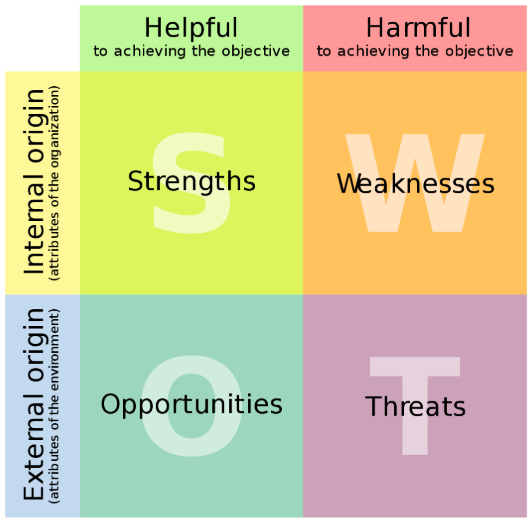Measuring and managing quality
15 de February, 2021Metrics
23 de February, 2021What needs to be done to get your product closer to the product vision? This is your strategy and product objectives. We are then talking about defining what to do, how to do it, in what order to do it, and what metrics tell us that we are going in the right direction once the why to do it has already been defined in the product vision.
The strategy and objectives provide a path to be followed and metrics that show whether or not we are in the right direction. Without a clearly defined strategy and objectives, it is very difficult to define the most appropriate team structure and what needs to be done to achieve these objectives.
Creating your product strategy
As you already have your product vision, you need to understand what you need to do to execute your product vision, that is, to get where you want to go.
Below are some tools that will help you create your product strategy:
Market analysis
As explained in my book “Product management: How to increase your software’s chances of success“, to create your strategy, you need to have a good understanding of your market in five aspects:
- competitors: both direct and indirect, that is, those who compete for the time and attention of your users. For example, a competitor of physical activity is streaming services, which motivate its users to watch more and more videos.
- potential and accessible market: how much market, that is, how many people could be your customers? In order to be your customer, are there any minimum requirements? For example, if you sell an online course to medical interns preparing for the assessment process to join a medical residency program, your potential market is all medical students in their final years of graduation. This is your potential market. And out of that total of people, how many people can you actually talk to and who will want to use your product? In the example above of the online course for medical students, how many can you talk to and show your product? This is your accessible market.
- market growth: is the number of people with the potential to use your product growing, stable, or decreasing? And how many people can you talk to about your product? It is very important to understand if the market you see for your product is growing, stable, or decreasing, and if this movement is in the short or long term. Understanding how your market is moving is fundamental to help you define your strategy.
- disruptors: as important as knowing your direct and indirect competitors, you need to know which products can disrupt your product, that is, replace the benefit that your product delivers in a better and more attractive way for your users. For example, people are using less and less email due to the communication options that direct messaging products like WhatsApp and Slack have offered.
- regulation: is your market regulated? Do you know this regulation? Were there any changes in this regulation? For example, at the Conta Azul, we monitored tax and accounting regulations on a daily basis to ensure that the product was in line with those regulations.
This work must be coordinated by the head of product in conjunction with the marketing leadership. Probably this type of analysis has been done in a timely manner. My recommendation is to make market analysis a permanent discipline, that is, once the first version with the items above has been created, update monthly to ensure you have the most up-to-date information about your market.
SWOT Analysis
From your market analysis, the next step is to understand your product’s position in this market. Both the current position and the position you want to occupy when you have executed your product vision. A good tool to help with this understanding is to do SWOT analysis, which stands for Strengths, Weaknesses, Opportunities, and Threats.

Strengths and weaknesses are internal items (from your product development team, or your company) over which you, your team, or your company have some control, items that help or hinder your product to achieve your vision. Opportunities and threats are the elements external to the organization, that is, over which the organization has no control, and which can positively or negatively influence the achievement of the product’s vision. It has to do with the market analysis described above.
Filling in the SWOT should be a team effort. The heads of product must have one or more sessions together with people who can contribute to this analysis. Leaders of your team and other areas are the right audiences for this type of session. How to organize a SWOT analysis session:
- Homework: ask everyone to complete a SWOT analysis. Limit to a maximum of three items per quadrant. It is common, especially in the weakness quadrant, for people to create a very large list of items, often with more than 10 weaknesses. When asking to limit by 3 items per quadrant, people will be forced to do a first prioritization.
- Consolidation: combine all SWOT analyzes into one analysis. There will be some overlaps and some differences. Place items in each quadrant with the number of people who placed each item in their individual SWOT analysis. This amount can serve as the first indication of prioritization.
- Final version: bring people together in a conversation to evaluate the consolidated version. The goal now is to make the consolidated version also have a maximum of 3 items per quadrant to force everyone to prioritize once again. Usually, a single session can be enough to build this final version.
Once you have your final version of the SWOT analysis, you have 12 items that can serve as the focus of your strategy. I say “can” because you don’t have to work on all the items at the same time. Here, once again, the ability to prioritize comes in. Bearing in mind that SWOT was designed to help us show the path that needs to be taken to achieve our product vision.
- Strengths: how to keep them relevant? Do you need to do anything to reinforce them? Are any of your strengths more important than the others?
- Weaknesses: How to reduce the impact of weaknesses? Which of these weaknesses has the greatest impact?
- Opportunities: is it possible to explore opportunities? What can we do to explore opportunities? Which of the opportunities is most relevant to the execution of the product vision?
- Threats: What should we do to protect ourselves from threats? How do these threats impact the execution of the product vision?
These discussions should also be held in groups, and can even be done in the continuation of the creation of the SWOT analysis. With these discussions, you will already have an alignment between the leadership of the different areas regarding the product strategy.
OKR
OKR means Objective and Key Results. It is a management tool that serves to align and monitor the execution of the strategy. This tool has been used at Google since its inception and was brought there by John Doerr, an employee of Intel, the company where this tool was created. Several technology companies today use OKRs, such as Locaweb, Conta Azul, Gympass, Linkedin, Amazon, Adobe, Baidu, Dropbox, Facebook, Netflix, and Spotify. OKR is a framework derived from a management technique called Management by Objectives, a term created by Peter Drucker in his book The Practice of Management, from 1954.
It is a very simple yet powerful tool. You define together with the team some objectives for a period – usually a quarter or a year – and define which metrics you will use to show that the objective is being reached. Each objective can address one or more items in your SWOT analysis or represent something that you want to execute from your vision.
For example, let’s say one of your goals is “Achieve record purchases per month in our website”. To achieve this goal, you can define the following key results:
- Increase from 15,000 to 20,000 visits per week
- Improve the conversion rate from 4.5% to 6%
- Lower the bounce rate from 35% to 20%
- Improve page load times to less than 2 seconds
The team should look at the OKRs every week to see if the metrics are moving in the right direction and understand if there are any impediments to be removed or something to be done to accelerate the achievement of the objectives. More frequent deliveries and measurements help to achieve objectives. If there are only monthly deliveries and measurements, the team will only have two chances in the quarter to test their idea of ​​how to move the metric. If there are weekly deliveries and measurements, there are 12 opportunities to evaluate and change course if necessary.
There, you now have your product strategy, the objectives you want to achieve, and the metrics that will tell you if you are reaching your objectives. Your next step will be to define the most appropriate team structure to execute your strategy and achieve your goals, a topic for the next chapter.
Reviewing your product strategy
Your product evolves as the team works on it and you get closer to your product vision. Much is learned about the users of the product, their problems, and needs. New alternatives may appear to help its user to solve their problems and needs. The owner of the digital product can also revisit his strategic objectives and, consequently, revisit the objectives defined for the digital product.
In addition, strengths and weaknesses can change over time, and opportunities and threats can appear or disappear. So it is important to understand that neither the vision nor the product strategy and objectives are written in stone. They can and should be revisited periodically.
My suggestion is that they be revisited annually, or when some relevant event happens, such as when there is a change in the company’s strategic objectives, or when an alternative appears that solves the user’s problem or need in a different way than yours. product, or when a crisis like the COVID-19 pandemic occurs.
For OKRs, my suggestion, as mentioned above, is that they are defined quarterly and reviewed weekly. This will give your team a good execution cadence.
Summing up
- Product strategy is nothing more than the path you will take to arrive at your product vision.
- To create the product strategy you need to have a good understanding of your market, that is, the competitors, the potential and accessible market, the growth of this market, if there are disruptors, and regulation of that market.
- Use SWOT analysis to help you define which points you will work on in your product strategy.
- Use OKRs to help you define your strategic objectives and metrics that will tell you if you are on the right track.
- Review at least annually, or when there are relevant events in the market, your strategy, and your product vision. The market changes, your product evolves, so your product vision and strategy must also evolve.
In the next chapter, we will see different ways to structure the development team in order to execute the product strategy in order to achieve the product vision.
Missing something?
So, did you miss something in this chapter? What else would like me to cover?
Digital Product Management Books
Do you work with digital products? Do you want to know more about how to manage a digital product to increase its chances of success? While you wait for my new book, check out my Digital Product Management bundle with my 2 books where I share what I learned during my almost 30 years of experience in creating and managing digital products.

